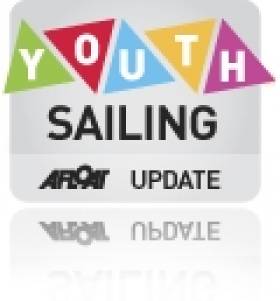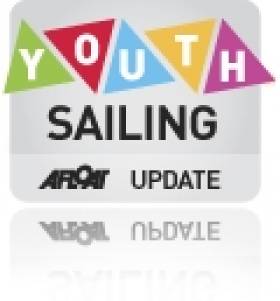Displaying items by tag: Seafra Guilfoyle RCYC
Youth Sailors Draw Crowds at Youth Olympics
#youthsailing – The four Techno 293 and Byte CII fleets played to a crowd of 2,000 at the Youth Olympic Games as racing commenced on Lake Jinniu in Nanjing, China. In spite of Ireland's recent prowess at youth sailing in both the Laser Radial and the Topper dinghy, the 60–nation event does not include Ireland as the Irish Sailing Association (ISA) says it does not have a budget for same. Ireland also does not attend the Youth Olympics because the Byte dinghy is not an 'ISA pathway class'. However Irish Rowing does attend the Youth Olympic Games and this morning, rising star Eimear Lambe qualified for the semi–final stage.
Sailing tickets have completely sold out for the Youth Olympic Sailing Competition and with a full view of Race Area A the crowd witnessed three Techno 293 Boys and Girls races and a single Byte CII race towards the end of the day.
In a north east breeze blowing between 5-6 knots the Techno 293 completed their schedule with Francisco Saubidet Birkner (ARG) leading the boys and Lucie Pianazza (FRA) in charge in the girls.
The Byte CII fleets started the day on Race Area B with a tricky breeze making life difficult for the Race Committee. They managed to complete one race before moving to Race Area A following the windsurfers completing their schedule. Nonetheless two out of three scheduled races were completed and Pedro Correa (BRA) tops the tree in the male fleet whilst Alexandra Dahlberg (FIN) has the advantage in the girls.
Techno 293 Boys
Argentina's Francisco Saubidet Birkner was the stand out performer of the day in the Techno 293 fleet as he notched up two bullets and a sixth to take the lead.
Dutch racer Lars van Someren opened the day up by taking the first bullet in front of 2,000 paying spectators. With clean air in his sail he led Brazil's Daniel Pereira and never looked threatened as the race played out, "It was quite good. At the start I was the only one who found the right shift which put me quite far ahead of everybody so the rest of the race was a sail to the finish."
If sailing at the Youth Olympic Games wasn't an amazing experience in its own right, a sell-out spectator stand increased the 'wow factor' just a little bit more, "It's like the first time there's a crowd in our windsurfing," said van Someren. "The stand is like packed full. It's a lot of fun. It's amazing. We sailed by after the race and everybody was cheering and everything. I saw my dad jumping up and down."
Van Someren came through with a fourth in the second race but fell to tenth in the third and final race of the day. Saubidet Birkner holds top spot on eight points with Japan's Kensei Ikeda second on 12 points. Van Someren is third on 15 points.
Techno 293 Girls
Consistency was key on the Techno 293 race course and France's Lucie Pianazza was the steadiest performer on the track.
Pianazza leads on nine points and explained her day, "It was a little difficult but I was second for the first race and then third and fourth. The wind is difficult to see but I think that I did the best day I could do."
Ahead of their races the girls checked in with the crowd giving them smiles and waves and Pianazza thoroughly enjoyed playing to the spectators, "There was a lot of people. It was wonderful and it is really great to see everyone. I sailed just in front of them and it was really good. It's a very impressive organisation and it's great with all the bonds between the sailors. There were a lot of people to see sailing and it's a very big event."
The crowd had something to cheer about on the final race of the day as host nation sailor Linli Wu claimed the final bullet of the day. The Chinese sailor took a fourth and a seventh in the races prior and sits second overall. Russia's Mariam Sekhposyan is in third, tied on 12 points with the Chinese racer.
Byte CII Girls
The biggest smile in the Girls Byte CII fleet came from Finland's Alexandra Dahberg and with good reason as well. The Finnish sailor took a pair of bullets and with a smile from ear to ear she was visibly delighted with the day, "I did pretty well, better than I expected with two wins so I couldn't be any happier," giggled the Finnish racer. "It was really successful today. My speed was great and I had good tactics so it just went well together.
"Tomorrow is totally new and I am going to take everything to zero and just do my best."
On the Youth Olympic Games Dahlberg added, "It's been amazing; the place is amazing and the people and everything. It's a good experience. The Opening Ceremony was awesome, it was spectacular. I like that there are people all around the world in different sports. It's totally different and new experience."
Singapore's Samantha Yom is second overall on seven points with The Netherlands Odile van Aanholt sitting third.
Byte CII Boys
Pedro Correa (BRA) was strong in the light breeze and opened up the competition with a race victory. A fourth followed in the second race and he has a one point advantage over Malaysia's Asri Azman.
"It was quite difficult because we had shifty wind and light wind and the starts were not easy," explained Correa. "I was always in the top five in the first race and then I saw a big gust and then I went to that and got distance and then it was just stay at the front until the finish.
"I did pretty well today but I can't be happy and I need to stay focused because there are a lot more races."
Asri Azman (MAS) took the second race victory and is a point behind in second. Peru's Angello Giuria is third overall.
Racing resumes on Tuesday 19 August at 11:00 local time with three races scheduled for the Byte CII fleets and two for the Techno 293 fleets.
The four YOG Sailing events are:
Boy's Windsurfer - Techno 293
Girl's Windsurfer - Techno 293
Boy's One Person Dinghy - Byte CII
Girl's One Person Dinghy - Byte CII
Cork Harbour's Guilfoyle Leads Lasers at Youth Nationals
#youthsailing – Fresh from his significant 15th overall a week ago at the Laser Europa Cup in Marseille, Royal Cork's Seafra Guilfoyle took a three point lead after the initial three races in today's opening rounds of the youth national championships off Howth. Guilfyole has a 3, 1, 1 putting him in pole position ahead of Kinsale's Ross O'Sullivan and Royal Cork club mate Cian Byrne, who were also competing in France.
420 dinghy locals Robert Dickson and Sean Waddilove won the first two races and finished second in the final race of the day in the double–handed class. They lead Royal Cork's Harry Whitaker & Grattan Roberts and Peter McCann & Arran Walsh.
Full results here.
#laser – The complete absence of any Irish Laser Radial presence at Weymouth for the RYA youth nationals this week is explained by the eight Irish sailors competing at the Laser Europa Cup in Marseille, France. Royal Cork's Seafra Guilfoyle produced a significant 15th overall and top Irish result in the 158–boat fleet. A total of 346 sailors with ages ranging from 15 to 79 competed in this edition of the 2014 series.
Other Irish results were 21 Cian Byrne, 36 Ross O'Sullivan, 48 Dara O'Shea, 66 Ryan Glynn, 71 Liam Glynn, 84 Sarah Eames and 93 Sorcha Ni Shuilleabhan.
French sailor Romain Simonnot (FRA) took the title in the Radial fleet finishing on 21 points followed by another tie between second and third place. Marie Bolou (FRA) and William De Smet (BEL) were tied on 25 points with the French sailor breaking the tie having recorded more third place finishes.
There was a bit of everything wind wise including shifty light to around 15 knots at times.
Racing which concluded today got off most days at around noon except for the third day when the first start was at about five and sailors docking as the sun went down.
First place on the podium for the Standard fleet went to Maxim Nikolaev (RUS) who after 8 races and one discard finished on 17 points.
There was a tie of 19 points for second and third place. Antony Munos (FRA) with two bullets on the final day grabbed second overall and Thorbjorn Schierup (DEN) took third.
The largest fleet of all with a total of 119 competitors was the Laser 4.7. Racing was dominated by Federico Fornasari (ITA) who finished on 10 points from 7 races including one discard. Second place went to Seref Unlu (TUR) on 33 points and Aurelien Pierroz (FRA) with 35 points wrapped up the podium.
Results here.































































